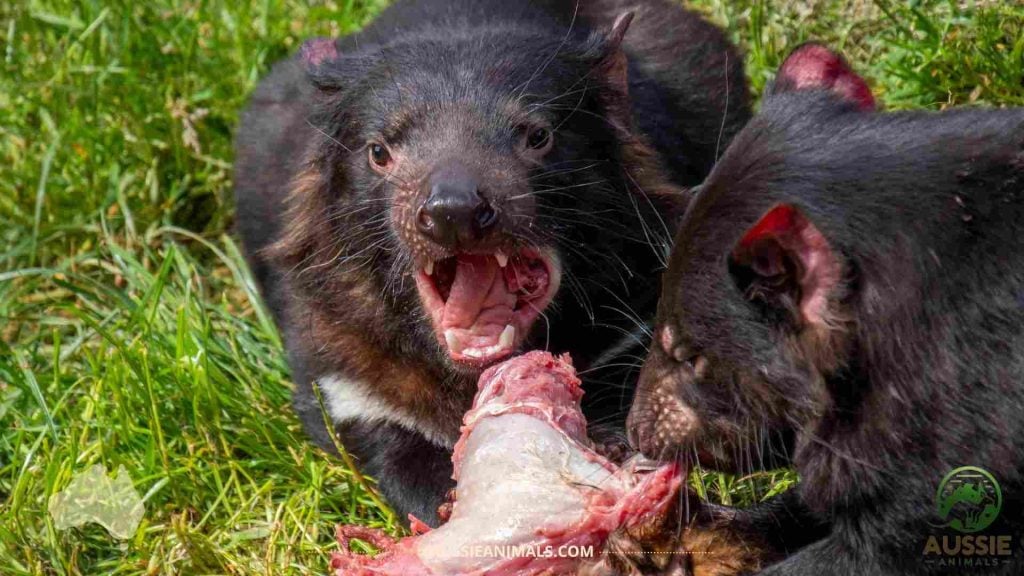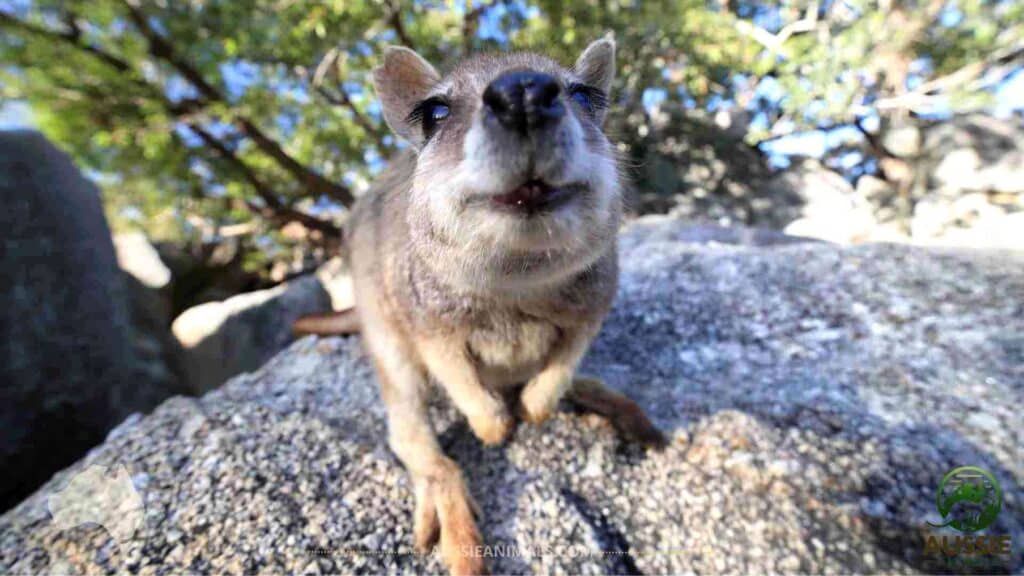
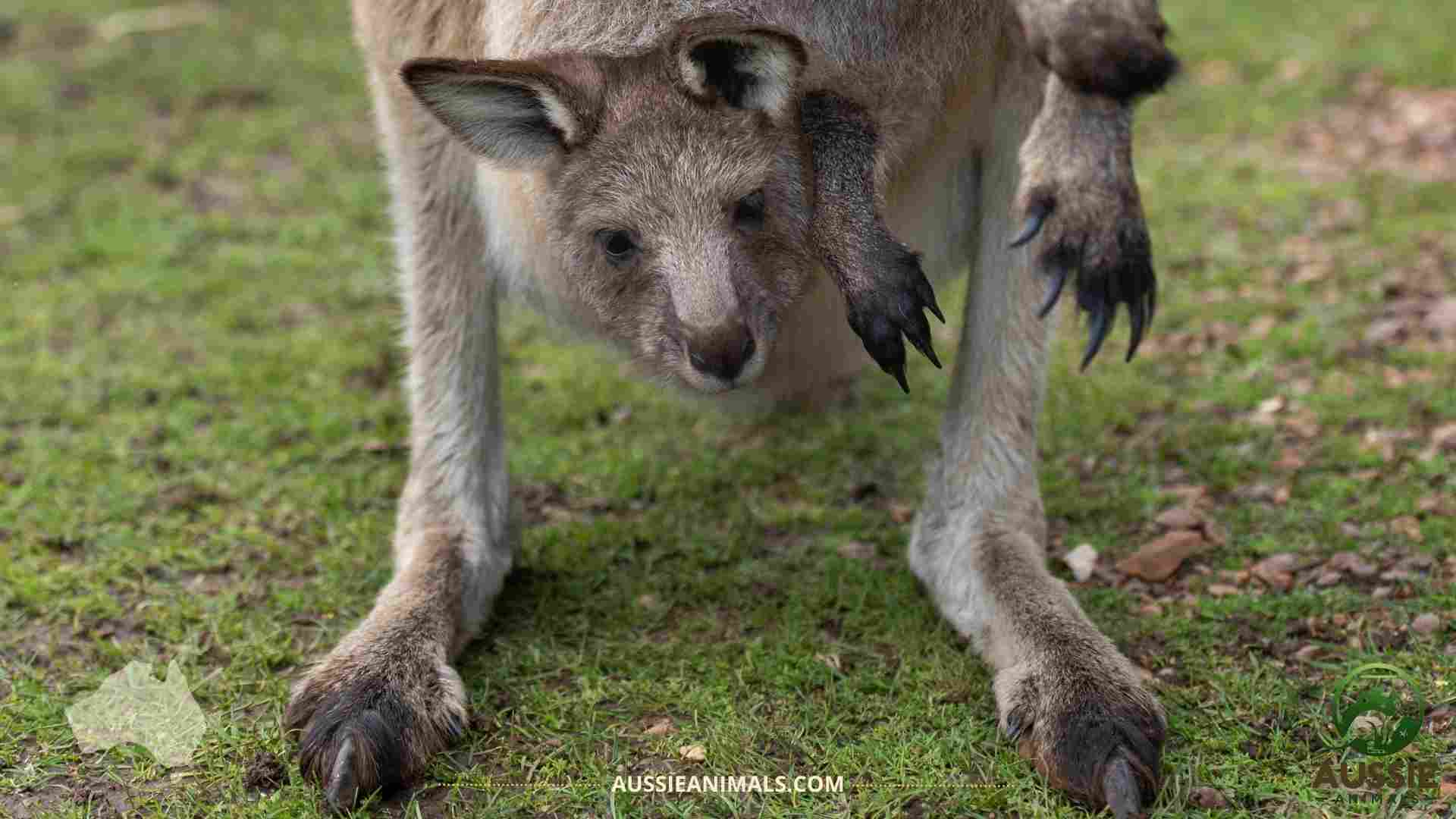

What Are Marsupials? Australia’s Amazing Mammals
Marsupials are a distinct group of mammals classified under the infraclass Marsupialia, primarily found in regions like Australasia, Wallacea, and the Americas. One of the most distinctive features of marsupials is their reproductive system, where offspring are born at a very early stage of development and continue to grow inside a pouch on the mother’s abdomen.
Today, approximately 70% of the 334 living species of marsupials are found on the Australian continent, which includes mainland Australia, Tasmania, New Guinea, and nearby islands. The remaining 30% are spread across the Americas, with the majority residing in South America, thirteen species in Central America, and just one species, the Virginia opossum, found in North America north of Mexico.
Australian Marsupials
The diversity of marsupials is huge, it includes well-known species such as kangaroos, koalas, possums, Tasmanian devils, wombats, wallabies, and bandicoots. This group of mammals shares a common ancestry within the metatherian lineage, which diverged from placental mammals at least 125 million years ago, possibly even earlier during the Middle Jurassic to Early Cretaceous periods. The term ‘marsupial’ originates from the Latin word ‘marsupium,’ meaning pouch. However, not all marsupials possess a true pouch. In some species, what might be considered a pouch is merely a protective fold of skin rather than a fully enclosed space where the young can reside during their development.
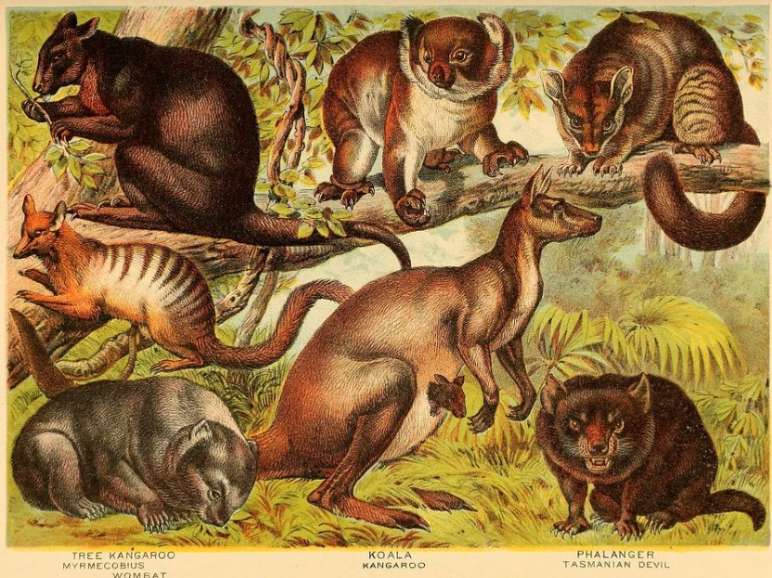
Dasyurids
These are the carnivorous marsupials, known for their meat-eating diet. This group includes species such as quolls, the Tasmanian devil, the extinct Tasmanian tiger (thylacine), numbats, dunnarts, and antechinus. These animals are typically equipped with sharp teeth and strong jaws, ideal for hunting and consuming other animals.
Peramelemorphs
Representing the omnivorous marsupials, this group includes bilbies and bandicoots. These marsupials have a varied diet, consuming a mix of insects, small animals, fruits, and plants, making them adaptable to different environments.
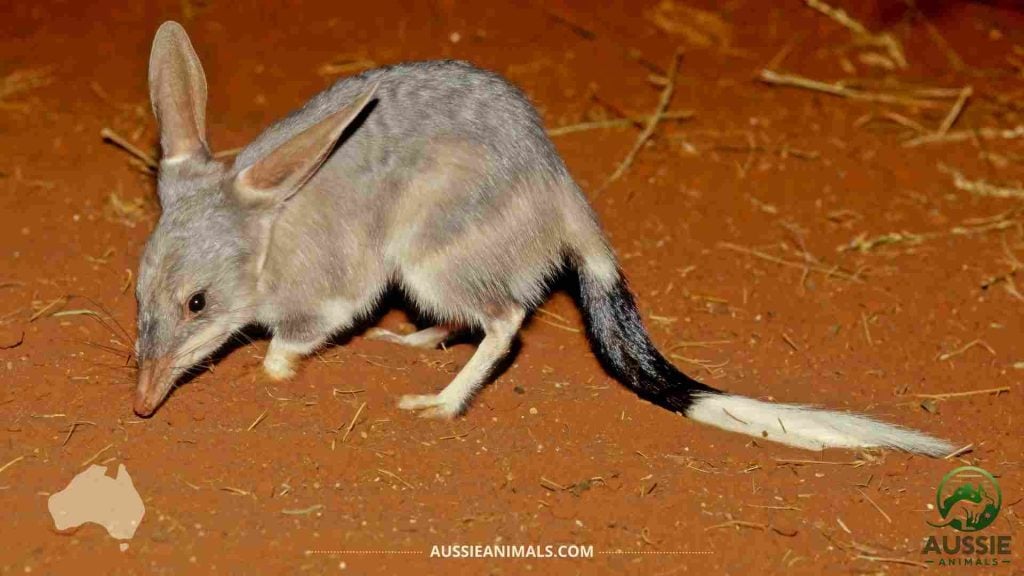
Diprotodonts
Primarily herbivorous, this group comprises some of Australia’s most iconic marsupials, such as kangaroos, wallabies, possums, koalas, and wombats. These animals are well-adapted to a plant-based diet, often specializing in grazing on grasses, leaves, and other vegetation.
Unique Traits of Marsupials
Marsupials possess several distinctive physical characteristics and adaptations that set them apart from other mammals. These unique traits have allowed them to thrive in a variety of environments, particularly in Australia, where they dominate the mammalian fauna.
Marsupials are born in an extremely undeveloped state. These tiny, hairless newborns have partially formed hind limbs, but their forelimbs are more developed, equipped with sharp, curved claws. These claws are crucial for the newborn’s journey from the birth canal to the safety of the mother’s pouch, a journey that spans many times the length of its small body at just one month of age.
Marsupials have a unique reproductive system. Unlike placental mammals, marsupials have a short-lived placenta that provides nourishment to the young for only a few days before birth. Once born, the newborn moves to the mother’s teats inside the pouch, where it continues to grow and develop, sustained by the mother’s milk.
Marsupials also have an extra bone in their pelvis known as the epipubic bone, which supports the pouch.
Many marsupials exhibit a feature called syndactyly, where the toes are partially fused together with webbing. The koala is a prime example of this adaptation.

Physical Characteristics
- One of the most common features of marsupials is the presence of a pouch, or marsupium, where the young, known as joeys, continue their development after birth. The pouch varies in structure and function among different species; in some marsupials, like kangaroos and koalas, it opens forward, while in others, like the bandicoots, it may open backward. The pouch protects the developing young and provides access to the mother’s teats for nourishment.
- Unlike placental mammals, marsupials give birth to extremely underdeveloped young. The gestation period is short, sometimes lasting just a few weeks. After birth, the tiny, underdeveloped joey crawls into the mother’s pouch, where it latches onto a teat and continues to develop for several months.
- Marsupials typically have a distinctive dental formula and skull structure, adapted to their diet. For example, carnivorous marsupials like the Tasmanian devil have sharp, pointed teeth for tearing flesh, while herbivorous marsupials like kangaroos have flat molars for grinding plant material.
Adaptations

These unique traits and adaptations highlight the incredible diversity and specialization of marsupials, allowing them to occupy a wide range of ecological niches across Australia and beyond.
- Marsupials exhibit a wide range of dietary adaptations. Herbivorous species, such as koalas and kangaroos, have specialized teeth and long digestive tracts to process fibrous plant material. Carnivorous species, like quolls, have powerful jaws and sharp teeth for capturing and consuming prey. Some, like the numbat, have evolved long, sticky tongues to feed on termites and ants.
- Marsupials have evolved various modes of locomotion to suit their environments. Kangaroos, for example, are known for their powerful hind legs and large feet, which allow them to cover great distances in leaps. Tree-dwelling marsupials, like tree kangaroos and koalas, have strong, curved claws for climbing and gripping branches.
- Many marsupials are nocturnal, which helps them avoid the heat of the day and reduces competition with diurnal animals. Their behaviors are also adapted to their specific habitats—koalas, for instance, spend most of their lives in eucalyptus trees and have evolved to conserve energy by sleeping up to 20 hours a day.
Where Australian Marsupials Live
Australia’s marsupials have adapted to a wide variety of habitats, ranging from lush forests to arid deserts. Each environment shapes the behavior, diet, and evolutionary traits of the species that inhabit it.
Forests and Woodlands
Many Australian marsupials, such as koalas, possums, and tree kangaroos, thrive in the dense eucalyptus forests and woodlands found in eastern Australia. These environments provide ample food sources and shelter, with many species evolving to become arboreal, spending most of their lives in the trees.
Grasslands and Savannas
Species like kangaroos and wallabies are well-suited to the open grasslands and savannas of Australia. These wide, open spaces allow for the large leaps kangaroos are known for, and their social structures often revolve around the availability of grass and other vegetation.
Deserts and Arid Zones
The arid central deserts of Australia are home to marsupials such as the bilby and the red kangaroo. These species have adapted to extreme conditions with behaviors like nocturnal activity to avoid the heat of the day, and specialized diets that allow them to survive on limited water sources.
Coastal Areas and Wetlands
Marsupials such as the quokka and swamp wallaby are found in the coastal regions and wetlands. These environments offer a mix of dense vegetation and access to water, influencing the diet and behavior of the marsupials that inhabit them.
Mountain Ranges
In the cooler, elevated regions of Australia, marsupials like the mountain pygmy-possum have evolved to survive in harsher climates with adaptations such as hibernation during the winter months.
These diverse habitats not only define where Australian marsupials live but also play a crucial role in their evolutionary development, leading to a rich variety of species uniquely adapted to their specific environments.
Marsupial Daily Life
Marsupials display a fascinating array of behaviors and social structures, with their daily life and interactions deeply influenced by their environment and evolutionary adaptations.
Social Structures
- Kangaroos: These Australian marsupials are known for their social behavior, often living in groups called “mobs.” Within these mobs, kangaroos establish a social hierarchy, with dominant males leading and protecting the group. Social interactions within mobs include grooming, play, and conflict resolution, usually through sparring or “boxing.”
- Koalas: In contrast, koalas are largely solitary animals. They spend most of their time alone in eucalyptus trees, only coming together during the breeding season. Koalas have defined territories that they mark with scent, and their interactions with other koalas are typically limited to mating or occasional territorial disputes.
- Tasmanian Devils: These marsupials are also generally solitary, but they may congregate when feeding on a large carcass. Despite their fierce reputation, Tasmanian devils exhibit complex social behaviors, including vocalizations and physical posturing to establish dominance without direct conflict.
Feeding Behaviors
- Nocturnal Foragers: Many marsupials, including possums and bandicoots, are nocturnal, meaning they are most active at night. This behavior helps them avoid daytime predators and the harsh Australian sun. They forage for food under the cover of darkness, relying on their keen senses of smell and hearing.
- Specialized Diets: Marsupials have evolved various feeding strategies to suit their habitats. For example, the koala feeds almost exclusively on eucalyptus leaves, which are toxic to many other animals. Their slow metabolism allows them to extract sufficient nutrients from this low-energy diet. Carnivorous marsupials, like quolls, hunt smaller animals and play a crucial role in controlling pest populations.
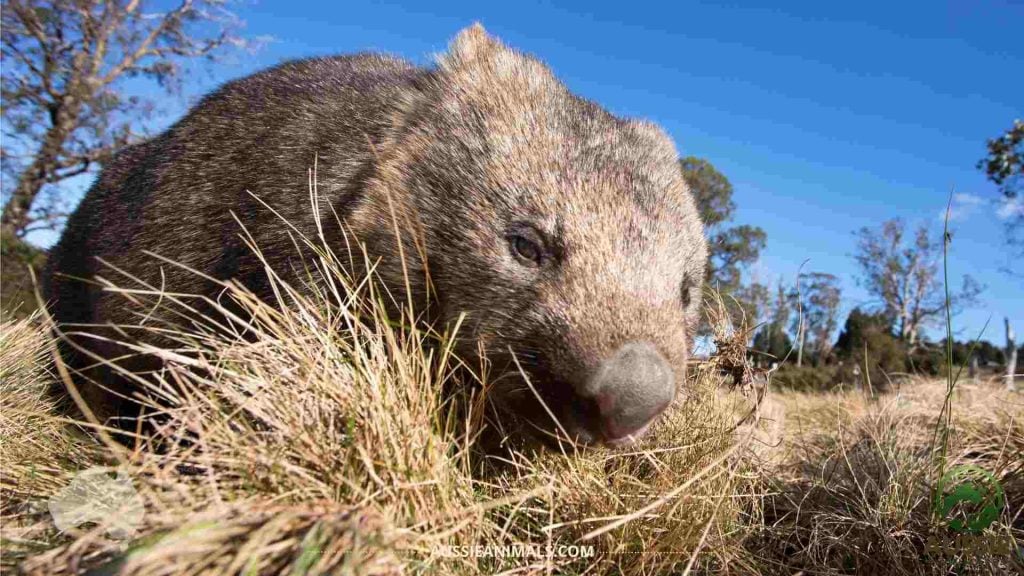
Mating and Parenting
- Mating Strategies: Marsupials exhibit a range of mating behaviors, from the promiscuous breeding of kangaroos, where dominant males mate with multiple females, to the more monogamous pairings seen in some possum species. The mating season can be highly competitive, especially for species where males must fight for access to females.
- Parental Care: Marsupial parenting is unique due to their reproductive strategy. After a short gestation period, the underdeveloped young, known as joeys, crawl into their mother’s pouch where they continue to develop. Marsupial mothers provide extensive care, with some species, like the kangaroo, carrying their young in the pouch for several months until they are mature enough to explore the outside world.
Marsupial behavior is incredibly diverse, reflecting the varied environments they inhabit across Australia. Their social structures, feeding habits, and reproductive strategies are all finely tuned to help them survive and thrive in some of the most challenging habitats on Earth.
Endangered Australian Marsupials
Australia’s marsupials are a remarkable and diverse group of animals, but many species face significant threats that put their survival at risk. Here’s an overview of their conservation status and the challenges they face:
- Critically Endangered Species – Several Australian marsupials are listed as critically endangered. The Northern Hairy-Nosed Wombat is one such species, with fewer than 300 individuals remaining in the wild. The Leadbeater’s Possum, found in the forests of Victoria, is another marsupial on the brink of extinction due to habitat loss from logging and wildfires.
- Endangered and Vulnerable Species – Other species, such as the Eastern Quoll and the Tasmanian Devil, are classified as endangered or vulnerable. The Eastern Quoll has disappeared from the Australian mainland and survives only in Tasmania. The Tasmanian Devil, once abundant, is now endangered primarily due to Devil Facial Tumour Disease (DFTD), a contagious cancer that has decimated populations.
- Stable and Thriving Species – Some marsupials, like the common kangaroo and koala, are not currently endangered but still face threats that could impact their future survival. While their populations remain stable, ongoing monitoring and conservation are necessary to ensure they do not become threatened.
Main Threats to Australian Marsupials
Habitat Loss
The most significant threat to Australian marsupials is habitat destruction, primarily due to agriculture, urban development, and deforestation. Many marsupials depend on specific habitats, such as eucalyptus forests or grasslands, which are increasingly being cleared for human use.
Climate Change
Changing weather patterns, more frequent and intense bushfires, and prolonged droughts are increasingly impacting marsupial habitats. Species like the koala, which relies on specific eucalyptus species for food, are particularly vulnerable as climate change affects the availability of their food sources.
Invasive Species
Introduced species such as foxes, feral cats, and rabbits have had a devastating impact on marsupial populations. These invasive predators hunt smaller marsupials, while herbivores like rabbits compete for food, further straining the environment.
Conservation Efforts
- Captive breeding programs have been established for several endangered marsupials, including the Tasmanian Devil and the Northern Hairy-Nosed Wombat. These programs aim to increase population numbers and reintroduce individuals into the wild.
- Efforts are underway to restore and protect critical habitats. For example, reforestation projects and the establishment of wildlife corridors help to reconnect fragmented habitats, allowing marsupials to move more freely and find food and mates.
- Programs to control or eradicate invasive species, particularly feral cats and foxes, are essential for protecting marsupials. These efforts include trapping, baiting, and fencing off critical habitats to create predator-free areas where marsupials can thrive.
- Ongoing research and monitoring are vital to understanding the needs of different marsupial species and assessing the effectiveness of conservation efforts. This includes studying the impacts of climate change and disease, as well as developing new conservation strategies.
While the challenges are significant, there is hope for Australia’s marsupials. Through continued conservation efforts, research, and public awareness, it is possible to protect these unique animals and ensure they continue to be a vital part of Australia’s natural heritage.

